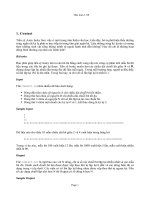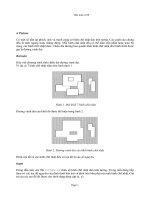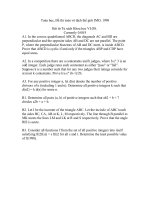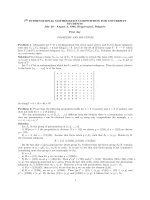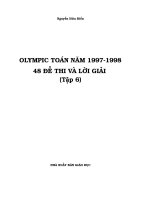D2628 91(reapproved 1998)
Bạn đang xem bản rút gọn của tài liệu. Xem và tải ngay bản đầy đủ của tài liệu tại đây (18.21 KB, 3 trang )
Designation: D 2628 – 91 (Reapproved 1998)
Standard Specification for
Preformed Polychloroprene Elastomeric Joint Seals for
Concrete Pavements1
This standard is issued under the fixed designation D 2628; the number immediately following the designation indicates the year of
original adoption or, in the case of revision, the year of last revision. A number in parentheses indicates the year of last reapproval. A
superscript epsilon (e) indicates an editorial change since the last revision or reapproval.
This standard has been approved for use by agencies of the Department of Defense.
Ozone Cracking in a Chamber (Flat Specimen)2
D 2240 Test Method for Rubber Property—Durometer
Hardness2
D 3183 Practice for Rubber—Preparation of Pieces for Test
Purposes from Products2
1. Scope
1.1 This specification covers the material requirements for
preformed polychloroprene elastomeric joint seals for concrete
pavements. The seal consists of a multiple web design and
functions only by compression of the seal between the faces of
the joint with the seal folding inward at the top to facilitate
compression. The seal is installed with a lubricant and is
designed to seal the joint and reject incompressibles.
1.2 The values stated in inch-pound units are to be regarded
as the standard.
1.3 This standard does not purport to address the safety
concerns, if any, associated with its use. It is the responsibility
of the user of this standard to establish appropriate safety and
health practices and determine the applicability of regulatory
limitations prior to use.
3. Materials and Manufacture
3.1 The seals shall be preformed, and the material shall be
vulcanized elastomeric compound using polychloroprene as
the only base polymer.
4. Physical Requirements
4.1 The materials shall conform to the physical properties
prescribed in Table 1.
4.2 In the applicable requirements of Table 1 and the test
methods, all deflections shall be based on the nominal width of
the seal.
NOTE 1—This specification is a manufacturing and purchasing specification only and does not include requirements or considerations for
selection of size, or the installation of the joint seals. However, experience
has shown that successful performance of this product depends upon the
proper selection of size and cross-sectional design of the joint seal, joint
size, and joint spacing for the ambient conditions the pavement will be
exposed to, and care in the installation of the joint seals.
5. Dimensions and Permissible Variations
5.1 The size, shape and dimensional variations shall be as
agreed upon by the purchaser and the producer or supplier.
6. Workmanship
6.1 Seals shall be free of defects in workmanship and
materials that may affect its serviceability.
2. Referenced Documents
2.1 ASTM Standards:
D 395 Test Methods for Rubber Property—Compression
Set2
D 412 Test Methods for Vulcanized Rubber and Thermoplastic Rubbers and Thermoplastic Elastomers—Tension2
D 471 Test Method for Rubber Property—Effect of Liquids2
D 518 Test Method for Rubber Deterioration—Surface
Cracking2
D 573 Test Method for Rubber—Deterioration in an Air
Oven2
D 575 Test Methods for Rubber Properties in Compression2
D 1149 Test Method for Rubber Deterioration—Surface
7. Sampling
7.1 A lot shall consist of the quantity for each cross section
agreed upon by the purchaser and the producer or supplier.
7.2 Samples shall be taken at random from each shipment of
material. If the shipment consists of more than one lot, each lot
shall be sampled.
7.3 A minimum of 9 linear ft (2.8 m) shall constitute one
sample for testing purposes.
8. Specimen Preparation
8.1 Cut or buff all test specimens from the sample of
preformed seal. Except as otherwise specified in the applicable
specifications or test methods, prepare specimens in accordance with the requirements of Practice D 3183.
8.2 Prepare specimens for determining tensile strength and
elongation using Die C (Test Methods D 412) when possible.
Die D may be used when the flat sections of a seal are too small
1
This specification is under the jurisdiction of ASTM Committee D-4 on Road
and Paving Materials and is the direct responsibility of Subcommittee D04.34 on
Preformed Joint Fillers and Sealers.
Current edition approved Jan. 25, 1991. Published March 1991. Originally
published as D 2628 – 67 T. Last previous edition D 2628 – 81.
2
Annual Book of ASTM Standards, Vol 09.01.
Copyright © ASTM, 100 Barr Harbor Drive, West Conshohocken, PA 19428-2959, United States.
1
D 2628
TABLE 1 Physical Requirements for Preformed Elastomeric Joint Seals
Property
Tensile strength, min, psi (MPa)
Elongaton at break, min, %
Hardness, Type A durometer, points
Oven aging, 70 h at 212°F (100°C)
Tensile strength, loss, max, %
Elongation, loss, max, %
Hardness, Type A durometer, points change
Oil Swell, ASTM Oil 3, 70 h at 212°F (100°C)
Weight change, max, %
Ozone resistance
20 % strain, 300 pphm in air, 70 h
at 104°F (40°C)
Low-temperature stiffening, 7 days at 14°F (−10°C)
Hardness, Type A durometer, points change
Low-temperature recovery,C 72 h at 14°F (−10°C)
50 % deflection, min %
Low-temperature recovery,C 22 h at − 20°F (−29°C), 50 % deflection,
min %
High-temperature recovery,C 70 h at 212°F (100°C), 50 %
deflection, min %
Compression-deflection, at 80 % of nominal width, min, lbf/in. (N/m)
Requirement
ASTM Test Method
2000 (13.8)
250
55 6 5
D 412
D 412
D 2240 (modified)A
D 573
20 max
20 max
0 to + 10
D 471
45 max
D 1149
(modified)B
no cracks
D 2240
0 to + 15
88
83
9.2D
9.2D
85
9.2D
3.5 (613)
9.3D
A
The term “modified” in the table relates to the specimen preparation. The use of joint seal as the specimen source requires that more plies than specified in either of
the modified test procedures be used. Such specimen modification shall be agreed upon by the purchaser and seller prior to testing. The hardness test shall be made with
the durometer in a durometer stand as recommended in Test Method D 2240.
B
Test in accordance with Procedure A of Test Method D 518.
C
Cracking, splitting, or sticking of a specimen during a recovery test shall mean that the specimen has failed the test.
D
The reference sections are those of this specification.
plate, or carefully remove the specimens from the assembly
and transfer them to a wooden surface in the refrigerated box.
Allow the specimens to recover for 1 h at 14 6 2°F (−10 6
1°C). Measure the recovered width in the center of the 5-in.
(127-mm) length at the top longitudinal edge of the specimen.
Measurements may be made with either a dial caliper or a
platform mounted dial gage graduated in thousandths of an
inch (0.02 mm). The platform mounted gage shall have a 1⁄4-in.
(6.35-mm) diameter pressor foot with a force of 0.186 0.02 lbf
(0.80 6 0.09 N). Take measurements with the platformmounted gage with the presser foot centered on the top
longitudinal edge of the seal. Calculate the recovery as follows:
for Die C. However, the requirements of Table 1 shall apply
regardless of the die used. Carefully perform buffing and keep
to a minimum.
8.3 Specimens for low temperature and high temperature
recovery tests and for compression-deflection tests shall consist
of 5-in. (127-mm) lengths of the preformed seal. Lightly dust
low-temperature recovery and compression-deflection specimens with talc on all internal and external surfaces. Lightly
dust specimens for high-temperature recovery with talc on the
external surfaces only but otherwise test in the as-received
condition.
8.4 Prepare specimens for ozone resistance in accordance
with Procedure A of Test Method D 518 and wipe with toluene
before testing to remove surface contamination.
Recovery, % 5 recovered width 3 100/nominal width
(1)
Report the least value of recovery to the nearest whole
percent.
9. Test Methods
9.1 Determine compliance with the requirements of Table 1
by conducting tests in accordance with the methods specified.
9.2 Recovery Tests:
9.2.1 Determine the low-temperature and high-temperature
recovery test values using specimens prepared in accordance
with Section 8. Use two specimens for each test and run the test
on both specimens at the same time as a pair.
9.2.2 Deflect the specimens between parallel plates to 50 %
of the nominal width of the seal using the compression device
described in Method B of Test Methods D 395. Prior to
compression, place the specimen in a horizontal position such
that the plane through both edges of the top surface of the joint
seal is perpendicular to the compression plates. As the specimen is being compressed, the top surface of the joint seal
should fold inward toward the center of the specimen.
9.2.3 Place a clamp assembly containing the compressed
specimens in a refrigerated box capable of maintaining a
temperature of 146 2°F (−10 6 1°C) for 72 h (Note 2). Then
unclamp the assembly and remove the upper compression
NOTE 2—The use of a desiccant such as calcium chloride in the
refrigerated box should be used to minimize frosting. The desiccant should
be changed or reactivated as frequently as necessary to keep it effective.
9.2.4 Place a clamp assembly containing the compressed
specimens in a refrigerated box (Note 2) capable of maintaining a temperature of − 20 6 2°F (−29 6 1°C) for 22 h. Then
unclamp the assembly and remove the upper compression plate
or carefully remove the specimens from the assembly and
transfer them to a wooden surface in the refrigerated box.
Allow the specimens to recover for 1 h at − 20 6 2°F (−29 6
1°C). Measure the recovered width and calculate the recovery
as in 9.2.3.
9.2.5 Place a clamp assembly containing the compressed
specimens in an oven capable of maintaining a temperature of
212 6 2°F (100 6 1°C) for 70 h. Do not preheat the clamp
assembly. Then unclamp the assembly and carefully remove
the specimens from the assembly and transfer them to a
wooden surface. Allow the specimens to recover for 1 h at 73
6 4°F (23 6 2°C). Measure the recovered width and calculate
2
D 2628
11.1.1 A certification of conformance to the specification
requirements. This shall consist of a copy of the producer’s test
report; or a statement by the supplier accompanied by a copy
of the test results, certifying that the material has been sampled,
tested, and inspected in accordance with the provisions of this
specification. Each certification so furnished shall be signed by
an authorized agent of the producer or supplier.
11.1.2 A certification of test results by an independent
testing agent and a statement that the material has been
sampled, tested, and inspected in accordance with the provisions of this specification. Each certification so furnished shall
be signed by an authorized agent of the testing agency.
11.1.3 Testing by the purchaser of any or all properties in
accordance with the provisions of the specification.
the recovery as in 9.2.3.
9.3 Compression-Deflection Test:
9.3.1 Determine the compression-deflection value using
specimens prepared in accordance with Section 8. Measure the
length of each specimen at the top, center and bottom using a
rule graduated in sixteenths of an inch (or millimetres).
Average the three measurements and record the length of the
specimen to the nearest 1⁄16 in. (1 mm). Run compression deflection tests on two specimens.
9.3.2 Place the specimen on its side in such a manner that a
plane through both edges of the top surface of the seal is
perpendicular to the platens of the compression testing machine and ensuring that the top of the seal folds inward during
deflection. Test in accordance with Method A of Test Methods
D 575 except do not use the sheets of sandpaper.
9.3.3 Deflect the specimen to 80 % of nominal width and
record the force in pounds-force (or newtons) on the compression portion of the third cycle.
9.3.4 Calculate the compression-deflection value at 80 % of
nominal width by dividing the force recorded by the length of
the specimen. Report the lowest value of compressiondeflection to the nearest 1⁄10 lbf/linear in. (N/m).
12. Product Marking
12.1 The seals shall be marked with the lot number, the
name or suitable trademark of the producer, or shall be
identifiable as to its manufacture by die markings. The top
surface of the seal shall be marked at 1-ft intervals in a manner
sufficiently clear and durable to enable making length determinations of the seal after installation in the pavement joints.
12.2 Containers in which the seals are packaged for shipment shall be clearly marked with the name of the producer, the
size of the seal, the lot number, and the date of manufacture.
10. Precision and Bias
10.1 Precision and bias statements are under development.
11. Certification and Acceptance
11.1 The acceptance of the preformed elastomeric seal shall
be based upon one of the following procedures, as specified by
the purchaser.
The American Society for Testing and Materials takes no position respecting the validity of any patent rights asserted in connection
with any item mentioned in this standard. Users of this standard are expressly advised that determination of the validity of any such
patent rights, and the risk of infringement of such rights, are entirely their own responsibility.
This standard is subject to revision at any time by the responsible technical committee and must be reviewed every five years and
if not revised, either reapproved or withdrawn. Your comments are invited either for revision of this standard or for additional standards
and should be addressed to ASTM Headquarters. Your comments will receive careful consideration at a meeting of the responsible
technical committee, which you may attend. If you feel that your comments have not received a fair hearing you should make your
views known to the ASTM Committee on Standards, at the address shown below.
This standard is copyrighted by ASTM, 100 Barr Harbor Drive, PO Box C700, West Conshohocken, PA 19428-2959, United States.
Individual reprints (single or multiple copies) of this standard may be obtained by contacting ASTM at the above address or at
610-832-9585 (phone), 610-832-9555 (fax), or (e-mail); or through the ASTM website (www.astm.org).
3
